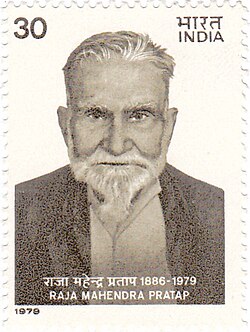Raja Mahendra Pratap
Thank you for being part of the Bharatpedia family! 0% transparency: ₹0 raised out of ₹100,000 (0 supporter) |
Raja Mahendra Pratap | |
|---|---|
 Raja Mahendra Pratap on a 1979 stamp of India | |
| President of the Provisional Government of India | |
| In office 1 December 1915 — January 1919 | |
| In office 1957–1962 | |
| Member of Parliament, Lok Sabha | |
| In office 1957 – 1962 | |
| Preceded by | Raja Girraj Saran Singh (Ind) |
| Succeeded by | Chaudhary Digambar Singh (INC) |
| Constituency | Mathura |
| Personal details | |
| Born | 1 December 1886 Hathras, North-Western Provinces, British India |
| Died | 29 April 1979 (aged 92) |
| Nationality | Indian |
| Alma mater | Minto Circle |
Raja Mahendra Pratap Singh (1 December 1886 – 29 April 1979) was an Indian freedom fighter, journalist, writer, revolutionary, President in the Provisional Government of India, which served as the Indian Government in exile during World War I from Kabul in 1915, and social reformist in the Republic of India.[1] He also formed the Executive Board of India in Japan in 1940 during the Second World War.[2] He also took part in the Balkan War in the year 1911 along with his fellow students of MAO college.[3] He is popularly known as "Aryan Peshwa".[4]
Early life[edit]
Pratap was born in the ruling Jat family[5] of the state of Mursan in the Hathras District of Uttar Pradesh on 1 December 1886. He was the third son of Raja Ghanshyam Singh. At the age of three, Raja Harnarayan Singh of Hathras adopted him as his son.[6] He was married to Balveer Kaur belonging to the ruling Sidhu Jat family of Jind, a princely state of Haryana (then in Punjab) in 1902 while studying in college.
Education[edit]
In 1895 Pratap was admitted to the Government High School in Aligarh, but soon he switched over to the Muhammadan Anglo-Oriental Collegiate School which later on became Aligarh Muslim University[6] Here he received his education under British Headmasters and Muslim teachers all from Muhammadan Anglo-Oriental College Aligarh founded by Sir Sayed Ahmad Khan.[7]
Nobel prize nomination[edit]
He was nominated for the Nobel Peace Prize in 1932.[1][8] N.A. Nilsson, his nominator, said about him-
While nominating for the Peace Nobel Prize, the nominator in a short biography, gave Singh's status as follows: Singh "is the editor of the World Federation and an unofficial envoy of Afghanistan. The nominator wrote a short biography as well as international political activities. Particularly his role in the Indo-Turco-German mission was highlighted. For instance, Kaiser Wilhelm of Germany and Sultan Mohemmod Rishad of Turkey gave him letters for the Afghan King. He arrived in Kabul on Oct. 2, 1915. On December 1, 1915, a Provisional Government for India was organised. Pratap was declared as its President. In 1917 he went to Russia and met Trotsky at Leningrad. From there he came back to meet Kaiser and Sultan, to give the message of the King of Afghanistan. He passed some time in Budapest and Switzerland. He was brought by German aeroplane to Russia, where he met Lenin. From there he went to Afghanistan. King Amanullah sent him on a mission to China, Tibet, Japan, Siam, Germany, Turkey and the U.S.A. After an agreement with the British, the King lost interest in Pratap. In the end, it is summarized: “He is primarily on an unofficial economic mission of Afghanistan. However, being born as an Indian he also wanted to expose the British brutalities in that land of the idealist Americans. At this juncture, when the great freedom movement of India is developing with large momentum it is in the interest of the spiritually minded as well as business people to study carefully this new phenomenon of our social life. …. He hopes to achieve some practical results in this direction during his present sojourn in this country (U.S.A.). He is planning to establish an Afghanistan information bureau and an office of the World Federation at Washington, D.C. He just tries to do his duty according to his best understanding and leaves the working of fate to the Laws of Nature!".. "It will be of interest to know – Why a Swede nominated Singh? The answer is to be found in the documents, which were sent with the nomination letter. Namely, Singh supported the idea of “World Federation”, about which N.A. Nilsson, propagated in 1910, as is evident from: “Fédération Internationale – Discours Au – xviii Congrés Universel de la paix (International Federation – Speeches in – xviii Universal Congress of Peace)."[9]
Freedom movement[edit]
In spite of objections from his father-in-law, Pratap went to Kolkata in 1906 to attend the Congress session, and met several leaders involved in the Swadeshi movement, deciding to promote small industries with indigenous goods and local artisans.
In January 1915 on learning about his presence in Switzerland, Chatto alias Virendranath Chattopadhyay of the newly founded Berlin Committee (Deutsche Verein der Freunde Indien) requested Von Zimmermann of the German foreign ministry to get Pratap invited to Berlin. Already Chatto had sent a first mission to Afghanistan led by the Parsi revolutionary Dada Chanji Kersasp.[citation needed]
Informed about Chatto's activities from Shyamji Krishnavarma and Lala Hardayal, Pratap insisted on meeting the Kaiser Wilhelm II personally; Chatto rushed to Geneva to tell Pratap of the Kaiser's eagerness to see him, and they went to Berlin together. Har Dayal, too, followed them. Decorating Pratap with the Order of the Red Eagle, the Kaiser showed his awareness of the strategic position of the Phulkian States (Jind, Patiala and Nabha), if India was invaded through the Afghan frontier.[citation needed]
According to Pratap's wish, he was taken to a military camp near the Polish border to gain a firsthand knowledge of army policies and functioning. On 10 April 1915 accompanied by the German diplomat Werner Otto von Hentig, Maulavi Barkatullah and a few other members, Pratap left Berlin, with due credentials from the Kaiser.
In Vienna the delegation met the Khedive of Egypt who during a conversation with Pratap expressed his desire to see the end of the British Empire. On their way, in Turkey they had a visit with Enver Pasha, son-in-law of the Sultan and Defense Minister, who appointed a trusted military officer to guide them. They were received by Rauf Bey with a detachment of 2000 soldiers at Ispahan. They reached Kabul on 2 October and were greeted by Habibullah, having a number of discussions.[citation needed]
Provisional Government of India[edit]
On 1 December 1915 Pratap established the first Provisional Government of India at Kabul in Afghanistan as a government-in-exile[10] of Free Hindustan, with himself as President, Maulavi Barkatullah as Prime Minister, and Maulana Ubaidullah Sindhi as Home Minister, declaring jihad on the British.[11] Anti-British forces supported his movement, but because of obvious loyalty to the British, the Amir kept on delaying the expedition to overthrow British rule in India.[citation needed]
In Japan[edit]
Return to India[edit]
He returned to India after 32 years on the ship City of Paris, and landed at Madras on 9 August 1946. On reaching India,he went to Wardha to meet Mahatma Gandhi.
1957 Lok Sabha Election[edit]
He was a member of the second Lok Sabha in 1957–1962. He was elected as an independent candidate in the 1957 Lok Sabha Elections from Mathura Lok Sabha constituency defeating Bharatiya Jana Sangh (which would later evolve into BJP) candidate and the future Prime Minister of India, Atal Bihari Vajpayee, who was in the fourth position among the list of five candidates.[7][12]
| Party | Candidate | Votes | % | ±% | |
|---|---|---|---|---|---|
| Independent | Raja Mahendra Pratap [13][14] | 95,202 | 40.68 | ||
| INC | Chaudhary Digambar Singh | 69,209 | 29.57 | ||
| Independent | Pooran | 29,177 | |||
| style="background-color: Template:Bharatiya Jana Sangh/meta/color; width: 5px;" | | [[Bharatiya Jana Sangh|Template:Bharatiya Jana Sangh/meta/shortname]] | Atal Bihari Vajpayee | 23,620 | 10.09 | |
References[edit]
- ↑ 1.0 1.1 Gupta, Sourabh (28 November 2022). "3 surprising facts about Jat King at the centre of AMU row". India Today.
- ↑ Singh, Vir. Life and Times of Raja Mahendra Pratap. Low Price Publications (India). ISBN 9788188629329.
- ↑ "The Role and Contribution of Raja Mahendra Pratap in Indian Freedom Movement" (PDF).
- ↑ "Raja Mahendra Pratap". India Post.
- ↑ Jaiswal, Anuja (6 May 2018). "Mahendra Pratap Singh: Now, Raja Mahendra Pratap Singh's grandson wants his portrait in AMU". The Times of India. Retrieved 30 September 2020.
- ↑ 6.0 6.1 Bhattacharya, Abinash Chandra (1962). Bahirbharate Bharater Muktiprayas (in Bengali), Kalikata:Firma K.L.Mukhopadhyaya, pp. 9–24
- ↑ 7.0 7.1 "Explained: Battleground AMU; A Raja and his Legacy". The Indian Express. 29 November 2014. Retrieved 30 October 2022.
- ↑ The Nomination Database for the Nobel Prize in Peace, 1901–1955. nobelprize.org
- ↑ Rajinder, Singh (2016) Inside Story of Nobel Peace Prize Award – Indian Contestants. Shaker, Aachen. pp. 21–30. ISBN 978-3844043389
- ↑ "Looking back at the times". The Hindu. 28 January 2015. ISSN 0971-751X. Retrieved 29 October 2015.
- ↑ Contributions of Raja Mahendra Prata by Hakim Syed Zillur Rahman, International Seminar on Raja Mahendra Pratap & Barkatullah Bhopali|Maulavi Barkatullah, Barkatulla University, Bhopal, 1–3 December 2005.
- ↑ Statistical Report on General Elections, 1957 to the Second Lok Sabha. Election Commission of India (1957)
- ↑ "General Election, 1957 (Vol I, II)". Election Commission of India. Retrieved 2 March 2021.
- ↑ साहिल, अफ़रोज़ आलम (1 October 2022). "बीजेपी को जिन राजा महेंद्र प्रताप पर प्यार आ रहा है, उन्होंने वाजपेयी को हराया था". ThePrint Hindi. Retrieved 8 September 2021.
Further reading[edit]
- The Kaiser's Mission to Kabul A Secret Expedition to Afghanistan in World War 1 by Jules Stewart, I.B.Taurus 2014 ISBN 978 178076 875 5
- Dr. Vir Singh (2004), My Life History: 1886–1979, Raja Mahendra Pratap, ISBN 81-88629-24-3
- "Mahendra Pratap (Raja)" in Dictionary of National Biography, 1974, Vol.III, pp10–11
- Les origines intellectuelles du mouvement d'indépendance de l'Inde (1893–1918) by Prithwindra Mukherjee, Paris, 1986 (PhD Thesis)
External links[edit]
- https://www.rajamahendrapratap.com/
- https://web.archive.org/web/20040910013359/http://www.punjabiamericanheritagesociety.com/paf/paf2000/ghadar_ki_goonj.html
- http://www.punjabilok.com/misc/freedom/history_of_the_ghadar_movement8.htm
- Mahendra Pratap materials at the South Asian American Digital Archive (SAADA)
- http://shodh.inflibnet.ac.in:8080/jspui/bitstream/123456789/508/2/02_introudction.pdf
- 1886 births
- 1979 deaths
- Indian independence activists from Uttar Pradesh
- 20th-century Indian journalists
- People from Hathras district
- Aligarh Muslim University alumni
- Hindu–German Conspiracy
- India MPs 1957–1962
- Lok Sabha members from Uttar Pradesh
- Journalists from Uttar Pradesh
- Indian male journalists
- People from Mathura district
- Jat rulers

